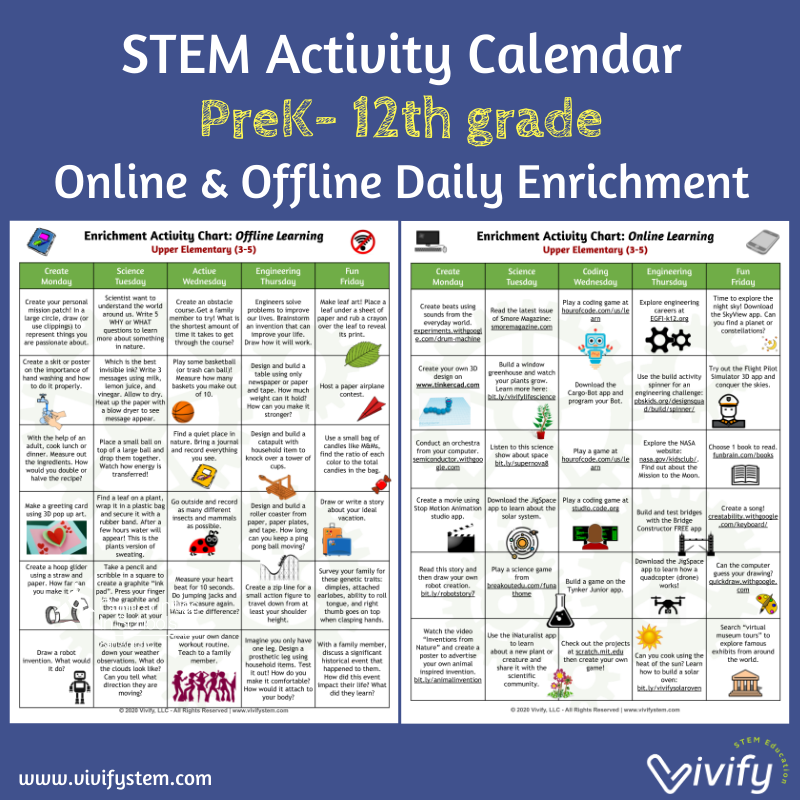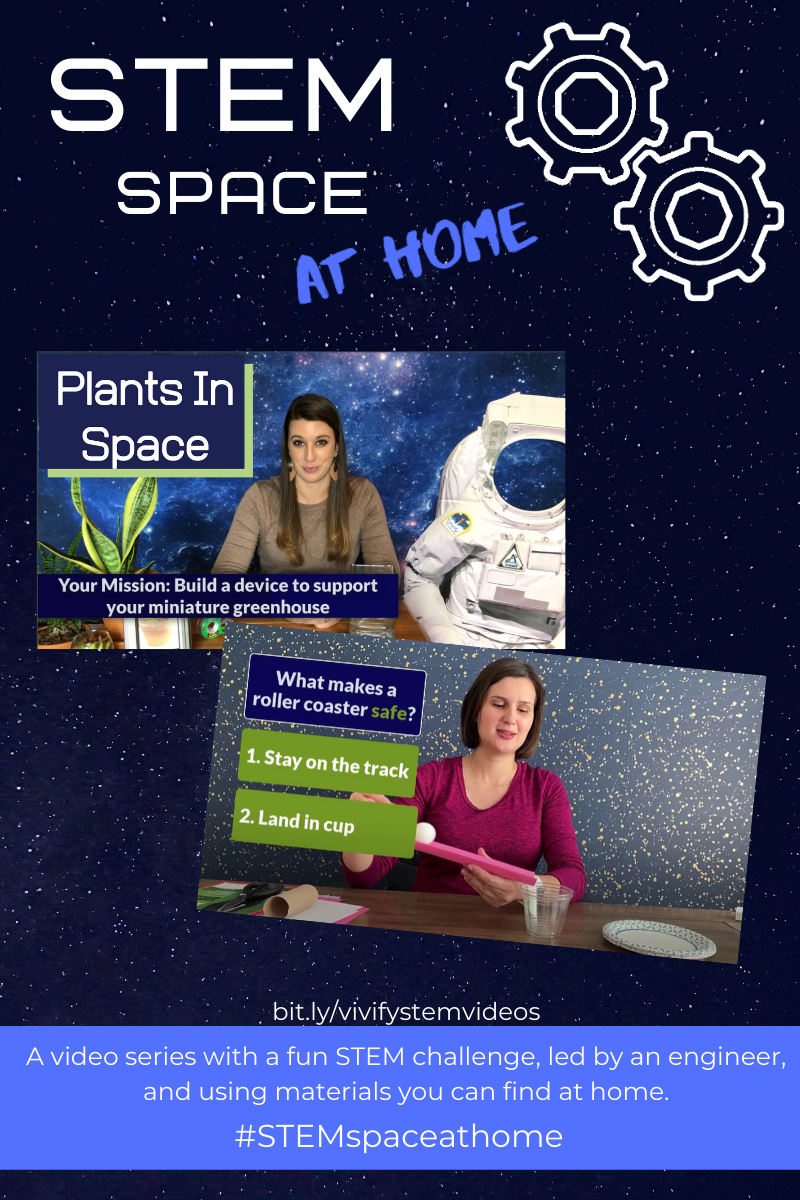STEM Activities for Distance Learning
Updated February 2024
My school is requiring physical distancing. How can we do STEM without working in groups?
There is no way I can sanitize supplies between classes! How can I plan for STEM lessons using individual materials?
Is project based learning even possible during distance learning? What does virtual STEM look like?
These questions keep popping up in our STEM Space Facebook group as educators frantically try to prepare for the fall semester. Due to COVID-19, some schools are planning for distance learning while others are requiring physical distancing and sanitation practices for classrooms. Is meaningful STEM learning even possible under these constraints? We say yes! Read on for our strategies to teach STEM during live virtual sessions, through student-driven distance learning, and in the classroom.
STEM Activities during Distance Learning
While distance learning is by no means an ideal situation for hands-on learning, we have put together some strategies that promote STEM skills.
For the beginning of the year, STEM learning usually centers around Stage 1 STEM activities. Click here to learn more about the Stages of STEM. Through a mix of team and individual activities, learning is focused on building foundational STEM skills such as communication, problem-solving, and creativity that are central to the engineering process. Click here for a list of 50 icebreakers for distance learning that can promote these critical skills.
We also recommend you check out our post for top take-home STEM resources including useful tools and activities.
Activity 1: STEM Quick Build Challenge
A STEM quick build challenge is perfect to engage students during a live virtual class! Select a building task that can be completed with a wide range of simple materials. Students can participate from home or during an individual build in a classroom setting.
Examples of STEM quick build challenges:
Build a bridge that holds weight
Build a tower taller than you
Build a tower to hold a stuffed animal
Build a zip line
Build a chain reaction
For a virtual class, ask students to gather available materials. You may also want to tell students to gather materials before the live class begins. Materials can be anything from paper, straws, paper plates or cups, toilet paper rolls, Legos, tape, newspapers, etc,
You may want to prompt students to draw an initial design before building, but they will likely be excited to jump right in! While brainstorming is important, this stage of STEM focuses more on the creativity, problem-solving, and perseverance during the building phase. Plus an added fun of this activity is the timed element. We recommend around 10 - 15 minutes for building. After building, have students share their completed design with classmates!
For more ideas on Stage 1 STEM building challenges, check out our teacher guide with 24 building challenges. The guide also includes editable task cards and student journals for Google Slides, Seesaw, Flipgrid, and printed take-home packets for in-class and virtual learning.
Activity 2: STEM Scavenger Hunt
Scavenger hunts are a fun way to engage students during distance learning! During this activity, students are tasked with finding different objects that represent a STEM word. Students have a blast running around the house finding objects, and the results are often hilarious! Scavenger hunts are definitely a fun way to break the ice during a live session while also introducing new vocabulary or checking for understanding.
To play, teachers can either post one task at a time or provide students with a BINGO type game board for more options. Example include asking students to find:
A wedge
A pattern
Something living
Something powered by electricity
An insulator
Something that floats
Before starting, make sure to review rules of the game including a time limit and safety. To be inclusive of students with limited mobility or limited access to materials, an alternative is to allow students draw the item.
For more scavenger hunt ideas including an activity guide, 34 task cards, and an editable BINGO game board, click below!
Activity 3: Intro to Coding Communication Challenge
Looking for an activity to promote communication and collaboration? We love using this intro to coding activity through virtual platforms or when students require physical distancing in the classroom.
Activity Set-up: There has been an emergency on the International Space Station! A special tool is required to make repairs, but only Robonaut (a robotic astronaut) can build this tool. NASA’s Mission Control must send commands to tell Robonaut exactly how to build the tool to save the astronauts on the ISS.
Overview: The purpose of the activity is to mimic how a computer scientist programs a robot. To complete this challenge, students will be put into pairs. Student A is NASA Mission Control that has the designs for a tool. Student B is Robonaut on the ISS and will receive commands on how to build the tool.
Materials required: In this challenge, one student will direct the other on how to build a specific object. This requires both partners having the same materials available. The challenge works best with building materials like Legos or Zoob. Students can also use paper, index cards, modeling clay, or other materials, but the more malleable the object the more difficult the instructions become to precisely replicate the tool.
How to implement the activity:
Live class session: A teacher or selected student provides commands and students attempt to build the tool.
Google Slides: Students submit their tool commands, and the teacher compiles into a Google Slides presentation. Students are then assigned to replicate classmates commands and upload a photo of their final design.
Flipgrid: Students post a video with commands on how to build the tool. Classmates respond by posting a video of their tool using the instructions.
For a full teacher guide include tips and editable templates for Google Slides and Flipgrid, check out the Intro to Coding activity below.
Activity 4: STEM Career Games
Looking to add careers to your virtual curriculum? We have two activities that are perfect for virtual learning.
STEM Careers BINGO Game: Learn about difference STEM careers with a twist on the classic BINGO game. For distance learning, one strategy is to send students a copy of the BINGO game through Google Slides. Each student selects a slide. Call out a career, and students can use the drawing tools to mark out the career. When a student wins, they can send a message or even share their screen for proof. Click for the Elementary School version for the Middle School versions.
Who is an Engineer or Scientist? STEM Career Game: Add even more career connections and uncover your students’ misconceptions by highlighting real living scientists and engineers that might not fit their stereotypes. Everyone knows that engineers are nerdy guys with glasses and scientists always have crazy hair! Help students break down the stereotypes around STEM careers by showing them that anyone, including them, can be an engineer or scientist!
Click here for the following activities that include digital and printed handouts on editable Google Slides.
"Am I Scientist Or Engineer?" Game on editable Google Slides with 18 professionals featured
Draw a scientist and engineer activity
Research a scientist and engineer activity
Reflection questions to discuss stereotypes around STEM
Activity 5: STEM At-Home Activity Calendar
Need to create activities for at-home learning? We created a calendar with 6 weeks of daily online and offline STEM activities. This includes versions for grades PreK, K-2, 3-5, 6-8, and 9-12. The calendar has also been fully translated into Spanish!
To implement, ask students to keep a journal or design notebook to record and reflect on activities. Another option is to have students upload weekly Flipgrid videos reflecting on the activities or share during a live class session. The activity chart can also be used for in-class learning that requires individual activities.
Activity 6: STEM At-Home Design Challenges
Want students to complete more in-depth engineering design challenges? Vivify has created a free series of instructional STEM videos. The series, STEM Space At Home, is led by an engineer using materials you can find at home. The videos are intended to support elementary and middle school students through fun engineering design challenges with a real-world connection. Videos include science demos, STEM career highlights, and a design challenge for your budding engineers to tackle right at home.
Click below for the full series of STEM Space At Home videos as well as all of our distance learning STEM activities. We hope these resources will help you prepare for an amazing school year!
Activity 7: STEM Digital Choice Boards
Bring real-world STEM careers and real-world connections through digital STEM choice boards! A fun, engaging, and low-prep activity, this bundle is perfect as an exploration activity, backup plan, or for a substitute teacher!
What is a STEM choice board?
A choice board is a graphic organizer that allows students to choose from different activities from a central theme. Teachers may have students choose one of the 4 activities or complete the entire set for multiple days of learning. These are a great way to bring real-world and career connections to your STEM classroom!
Click below for Vivify’s STEM Choice Boards including a space mission, virtual field trip, and STEM careers versions!











